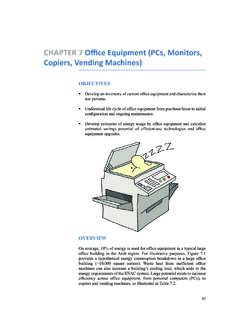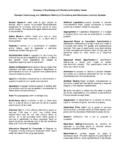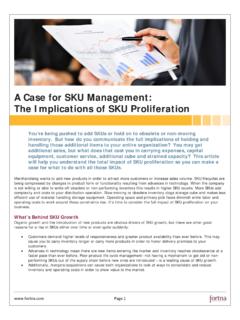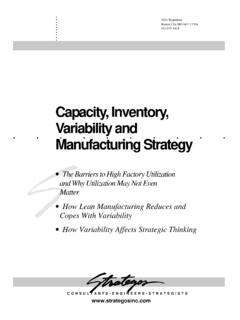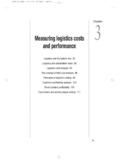Transcription of Manual on the management, maintenance and use of blood ...
1 World Health OrganizationGenevaSAFE blood AND blood PRODUCTSM anual on the management , maintenance and use of blood cold chain equipmentBCCmanualCover 106/06/2005, 2:26:13 PMManual on the management , maintenance and use of blood cold chain equipmentWorld Health OrganizationGenevaSAFE blood AND blood PRODUCTSBCC Manual 9306/06/2005, 2:23:53 PMAcknowledgementsThe Department of Essential Health Technologies acknowledges the continued support of the Government of Luxembourg towards the WHO blood Cold Chain Project. The publication was produced by Mr David Mvere, WHO Consultant and Dr Elizabeth Vinelli, National blood Council, Tegucigalpa, Honduras. Edited by Ms Kay Bond, EHT/WHO. The contribution of the following persons is particularly acknowledged:Mrs Beryl Armstrong, South African National blood Service, Pinetown, South AfricaDr Neelam Dhingra, World Health Organization Headquarters, Geneva, SwitzerlandDr Jean Emmanuel, National blood Transfusion Service, MalawiMs Jan Fordham, World Health Organization Headquarters, Geneva, SwitzerlandReviewers included.
2 Dr Noryati Abu Amin, World Health Organization Headquarters, Geneva, SwitzerlandDr Rama Bhasin, All India Institute of Medical Sciences, New Delhi, IndiaProfessor Kamel Boukef, National blood Transfusion Centre, Tunis, TunisiaDr Jose Cruz, World Health Organization Regional Offi ce for the Americas/Pan American Health Organiza-tion, Washington, , United States of AmericaDr Graham Harrison, World Health Organization Regional Offi ce for the Western Pacifi c, Manila, PhilippinesMrs Sh n Lloyd, World Health Organization Headquarters, Geneva, SwitzerlandDr Nishi Madan, University College of Medical Sciences, New Delhi, IndiaDr Ana del Pozo, Argentine Association of Hemotherapy and Immunohematology, Buenos Aires, Argentina World Health Organization 2005 All rights designations employed and the presentation of the material in this publication do not imply the expression of any opinion whatsoever on the part of the World Health Organization concerning the legal status of any country, territory, city or area or of its authorities, or concerning the delimitation of its frontiers or mention of specifi c organizations, companies or products does not imply that they are endorsed or recommended by the World Health Organization in preference to others of a similar nature that are not mentioned.
3 Errors and omissions excepted, the names of proprietary products are distinguished by initial capital World Health Organization does not warrant that the information contained in this publication is complete and correct and shall not be liable for any damages incurred as a result of its of the World Health Organization can be obtained from Marketing and Dissemination, World Health Organization, 20 Avenue Appia, 1211 Geneva 27, Switzerland (Fax: +41 22 791 4857; e-mail: Requests for permission to reproduce or translate WHO publications whether for sale or for noncommercial distribution should be addressed to Publications at the above address (fax: +41 22 791 4806; e-mail: Information on procuring medical equipment may be obtained from the Department of Con-tracting and Procurement Services, World Health Organization, 1211 Geneva 27, Switzerland. E-mail: by Sail Vega unless specifiedDesigned by minimum graphicsPrinted in IndiaWHO Library Cataloguing-in-Publication DataWorld Health on the management , maintenance and use of blood cold chain equipment .))
4 At head of title : Safe blood and blood preservation - instrumentation preservation - methods platelets - methods and supplies - standards uals 92 4 154673 5 (NLM classifi cation: WH 460)BCCmanual 9408/06/2005, 3:09:26 PMContentsiiiPreface viiUseful abbreviations ixGlossary x1 Introduction 1 blood : the raw material 1 Links in the cold chain 1 Target audience for this Manual 2 Using the Manual 3 Limitations of this Manual 32 Storage and transportation of blood and blood components 5 Safe storage of blood 5 Whole blood 5 Fresh frozen plasma 6 Cryoprecipitate 6 Platelet concentrates 7 Plasma derivatives 8 Cold chain samples and reagents 9 Packing and transportation of blood and blood components 9 Transportation of whole blood from the collection site to the laboratory 9 Transportation of blood components from one blood bank to another 11 Issuing blood components to clinical areas 123 blood storage equipment .
5 Refrigerators, plasma freezers and platelet agitators 15 Technical terms for specifi cations of blood cold chain equipment 15 Design features common to refrigerators and freezers 17 The cabinet 17 Ideal design features specifi c to blood bank refrigerators 19 BCCmanual 9506/06/2005, 2:23:57 PMMANUAL ON THE management , maintenance AND USE OF blood COLD CHAIN EQUIPMENTiv Ideal design features specifi c to plasma (and cryoprecipitate) freezers 21 Walk-in cold rooms and freezer rooms 21 Platelet agitators 22 The cooling mechanism and its maintenance (the refrigeration cycle) 23 Refrigerant gas 24 The compressor 24 The condenser 24 The evaporator 24 The thermostat 25 Ensuring electrical safety of the equipment 25 Care of refrigeration equipment 254 Other blood cold chain devices 27 Plasma thawing equipment 27 equipment for the transportation of blood 28 Technical terms used 28 blood transport boxes 28 Ice packs.
6 Cooling plates and cooling pouches 30 Temperature monitoring devices 30 Portable thermometers 31 Temperature recorders/thermographs 31 Manual recording of temperatures 33 Alarm systems 34 blood warmers 35 Essential accessories for all refrigeration equipment 35 Voltage regulators (stabilisers) 35 Stand-by generators 355 Installing blood refrigerators and plasma freezers 38 Action on reception of equipment 38 Siting of refrigerators and plasma freezers 39 Heat and light 39 Air circulation 40 Levelling 40 Door seals 40 Cleaning 41 Energy supply 41 Starting the equipment 41 Verifying installations and operational performance 44 BCCmanual 9606/06/2005, 2:23.
7 59 PM6 Organizing the blood cold chain 46 The structure of a national blood transfusion service 46 Activities of the blood bank 47 Critical stages in the movement of blood from collection to transfusion 48 Packing procedures for transportation 49 Receipt and handling on incoming, unprocessed blood and plasma derivatives 50 Receipt and handling of processed blood and blood components 51 Quarantine policies and procedures 51 Labelling of products 52 Method of storage of blood components in available stock 52 Release of whole blood /red cells for use from available stock 53 Procedures for thawing and releasing frozen plasma and cryoprecipitate 53 Procedures for the release of platelet concentrates 53 Discarded blood products and their safe disposal 54 Monitoring the blood inventory 55 Theoretical count 55 Physical count 56 Daily blood bank report 56 Unused blood components 56 Model list of essential blood cold chain equipment 59 Ensuring the blood cold chain during the issuing of blood
8 60 Withdrawal of blood from the blood bank, transfusion service or a satellite refrigerator 617 Preventive maintenance , care and repair of equipment 63 Organizing an equipment maintenance programme 63 Basic care and preventive maintenance of blood cold chain equipment and accessories 67 blood bank refrigerators and freezers 67 blood transport boxes 70 Platelet agitators 70 Plasma thawers 70 Stand-by generators 70 Basic preventive maintenance and repair tool kit 71 Calibration of cold chain devices and equipment 72 Disposal or decommissioning of cold chain equipment 728 Monitoring and evaluating the blood cold chain 74 Defi nition of terms 74 Planning for monitoring and evaluation 75 Quality indicators for evaluation 75vCONTENTSBCC Manual 9706/06/2005, 2:24.
9 02 PM Records 76 Reports 76 blood cold chain performance report 77 blood cold chain care and preventive maintenance log and repair record 77 Analysis and interpretation of data 78 Using the fi ndings from the monitoring and evaluation exercise 789 Guidelines for the development of a training programme 80 Obje c t ive s 80 Key points in the training programme 80 Preparing a training programme 80 Developing a training guide 81 References 84 Annex 1. The use of CFC in blood cold equipment 85 Annex 2. WHO Minimum performance specifi cations for blood cold chain equipment 87 Annex 3. Basic operational framework for the blood cold chain 92 Manual ON THE management , maintenance AND USE OF blood COLD CHAIN EQUIPMENTviBCCmanual 9806/06/2005, 2:24:05 PMPrefaceThe critical contribution that effective management and use of medical equipment brings to health service delivery is only recently gaining rec-ognition.
10 Managing medical equipment has often been misunderstood as the mere procurement of accessible products within a given budget. However, this narrow perspective has proven neither effective, nor cost-effective in the running of health services. The World Health Organiza-tion (WHO) promotes the adoption in countries of a comprehensive life cycle approach that falls largely into the following stages: (i) planning and decision-making ( policy, needs assessment and budgeting); (ii) acquisition (including selection, procurement and donation guidelines); (iii) installation (inspection, testing, acceptance, inventories and docu-mentation); (iv) monitoring of performance and use, including preven-tive maintenance , care and repair; and (v) fi rst two stages have been covered extensively in the publication The blood Cold Chain: Guide to the Selection and Procurement of equipment and In that Guide, WHO provided blood bank managers, procurement agencies and manufacturers with a description of, and minimum performance specifi cations for all the essential equipment needed for the effi cient stor-age and transportation of blood and blood components.










